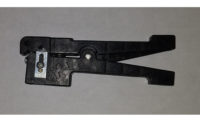
Back in my younger years, selling halon fire suppression systems for computer rooms was fun and easy. Whip out a tape measure and figure the volume of the room; warm up a pocket calculator and tell the client how much halon gas had to drop within 10 seconds to meet industry standards.
The halon system business faded away when mainframe computer systems were replaced with distributed networking, placing Ethernet switches in multiple telecommunications closets located around a building or enterprise. No longer was there a single room that needed complete protection against fire and other environmental problems. Now IT networks need various types of protection in each individual telecom closet.
As our IP security devices become co-located with IT enterprise devices, environmental detection within the telecom closet becomes a critical issue and an excellent opportunity for astute security system integrators to up-sell enterprise-level end-users. Increasing the detection capabilities within the telecom closets not only provides greater protection for mission-critical IT devices but also increases the ability of IP-based security devices and systems to perform without environmentally caused failures.
What sort of environmental situations should be monitored for and detected? Any kind of water leak can spell instant death for electronic equipment. Water detection should be installed in any ground floor or below-grade telecom closets, or any that have water pipes within the near vicinity. Rooms containing sub-floors are prime candidates for water detection installations.
What also can cause the failure of network servers and other devices is high temperature. Virtually every desktop and laptop computer has one (or more) air circulation fans built in that are always running when the computer is turned on. Most network servers are running on a 24/7 basis, so it follows that their cooling fans are also running constantly.
The failure of a fan will cause the CPU in the server to overheat, shutting down a critical network component. The blocking of an air vent on an equipment cabinet can cause the same type of problem.
To monitor that fans are operating properly and that the ambient temperature within a network equipment rack is within limits, American FiberTek (www.americanfibertek.com) has produced their P-TAH sensor, which stands for “probe - temperature, airflow, humidity.”
When connected to the Scout network-connected environmental monitoring device, all three environmental factors are constantly monitored. When selected thresholds are reached, the Scout can activate relays, send e-mails, and perform other notifications.
Because many telecom closets are typically unmanned, it is critical that any environmental monitoring system be capable of transmitting alarm notifications over the network. Local annunciation only will not do the trick.
When looking at adding detection and protection to a client’s telecom closets, don’t forget the obvious. Fire detection is a must, and remember that seconds count. Although our industry seems to prefer photoelectronic smoke detectors, consideration should be given to using ionization devices in telecom locations, because they react faster than photoelectronic ones when a fire starts.
Access control and intrusion detection also should be included in any type of comprehensive telecom closet detection package. Remember, when your proposed system is sharing the IT network or even just using some of the available rack space in the telecom closet, the security system is just as vulnerable as the IT network to environmental and physical security problems.

Book of the Month
Sound & Video Professional Reference DeWalt SecuritySmall enough to fit in your toolbag, this very handy reference manual covers most technical aspects of the connection and installation of CCTV, satellite receivers, sound systems and other low-voltage equipment. Detailed information on the pin-outs of various connector types, fiber-optic network standards and other quick-reference data is easy to find, along with many illustrations. This is a book that every technician should have on hand during installations.

